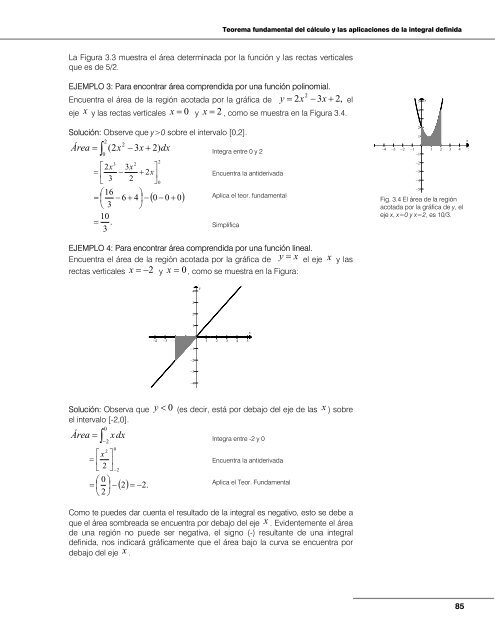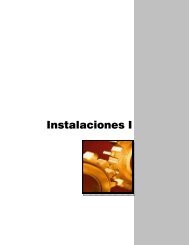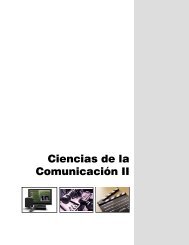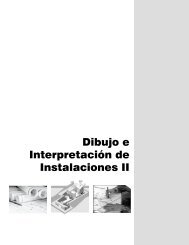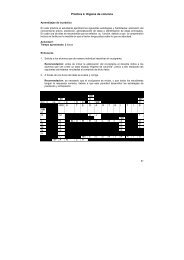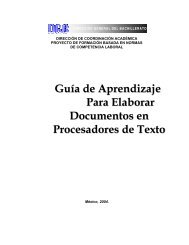Cálculo Diferencial e Integral II - Colegio de Bachilleres del Estado ...
Cálculo Diferencial e Integral II - Colegio de Bachilleres del Estado ...
Cálculo Diferencial e Integral II - Colegio de Bachilleres del Estado ...
You also want an ePaper? Increase the reach of your titles
YUMPU automatically turns print PDFs into web optimized ePapers that Google loves.
Teorema fundamental <strong>de</strong>l cálculo y las aplicaciones <strong>de</strong> la integral <strong>de</strong>finida<br />
La Figura 3.3 muestra el área <strong>de</strong>terminada por la función y las rectas verticales<br />
que es <strong>de</strong> 5/2.<br />
EJEMPLO 3: Para encontrar área comprendida por una función polinomial.<br />
Encuentra el área <strong>de</strong> la región acotada por la gráfica <strong>de</strong> 2 3 2,<br />
2<br />
y = x − x + el<br />
eje x y las rectas verticales x = 0 y x = 2 , como se muestra en la Figura 3.4.<br />
Solución: Observe que y>0 sobre el intervalo [0,2].<br />
= − +<br />
2<br />
2<br />
Área ( 2x<br />
3x<br />
2)<br />
dx<br />
∫<br />
0<br />
3 2 ⎡2x<br />
3x<br />
⎤<br />
= ⎢ − + 2x<br />
3 2<br />
⎥<br />
⎣<br />
⎦ 0<br />
⎛16<br />
⎞<br />
= ⎜ − 6 + 4⎟<br />
− 0 − 0 + 0<br />
⎝ 3 ⎠<br />
10<br />
= .<br />
3<br />
2<br />
( )<br />
EJEMPLO 4: Para encontrar área comprendida por una función lineal.<br />
Encuentra el área <strong>de</strong> la región acotada por la gráfica <strong>de</strong> y = x el eje x y las<br />
rectas verticales x = −2<br />
y x = 0 , como se muestra en la Figura:<br />
Solución: Observa que y < 0 (es <strong>de</strong>cir, está por <strong>de</strong>bajo <strong>de</strong>l eje <strong>de</strong> las x ) sobre<br />
el intervalo [-2,0].<br />
Área<br />
= ∫− 0<br />
2 dx x<br />
2<br />
0<br />
⎡ ⎤<br />
= ⎢ ⎥<br />
⎣<br />
x<br />
⎛ 0 ⎞<br />
= ⎜ ⎟ −<br />
⎝ 2 ⎠<br />
2 ⎦ −2<br />
( 2)<br />
= −2.<br />
4<br />
3<br />
2<br />
1<br />
Integra entre 0 y 2<br />
Encuentra la anti<strong>de</strong>rivada<br />
Aplica el teor. fundamental<br />
Simplifica<br />
−4 −3 −2 −1 1 2 3 4 5<br />
−1<br />
−2<br />
−3<br />
−4<br />
y<br />
Integra entre -2 y 0<br />
Encuentra la anti<strong>de</strong>rivada<br />
Como te pue<strong>de</strong>s dar cuenta el resultado <strong>de</strong> la integral es negativo, esto se <strong>de</strong>be a<br />
que el área sombreada se encuentra por <strong>de</strong>bajo <strong>de</strong>l eje x . Evi<strong>de</strong>ntemente el área<br />
<strong>de</strong> una región no pue<strong>de</strong> ser negativa, el signo (-) resultante <strong>de</strong> una integral<br />
<strong>de</strong>finida, nos indicará gráficamente que el área bajo la curva se encuentra por<br />
<strong>de</strong>bajo <strong>de</strong>l eje x .<br />
x<br />
Aplica el Teor. Fundamental<br />
5<br />
4<br />
3<br />
2<br />
1<br />
−4 −3 −2 −1 1 2 3 4 5<br />
−1<br />
−2<br />
−3<br />
−4<br />
−5<br />
Fig. 3.4 El área <strong>de</strong> la región<br />
acotada por la gráfica <strong>de</strong> y, el<br />
eje x, x=0 y x=2, es 10/3.<br />
y<br />
85<br />
x


